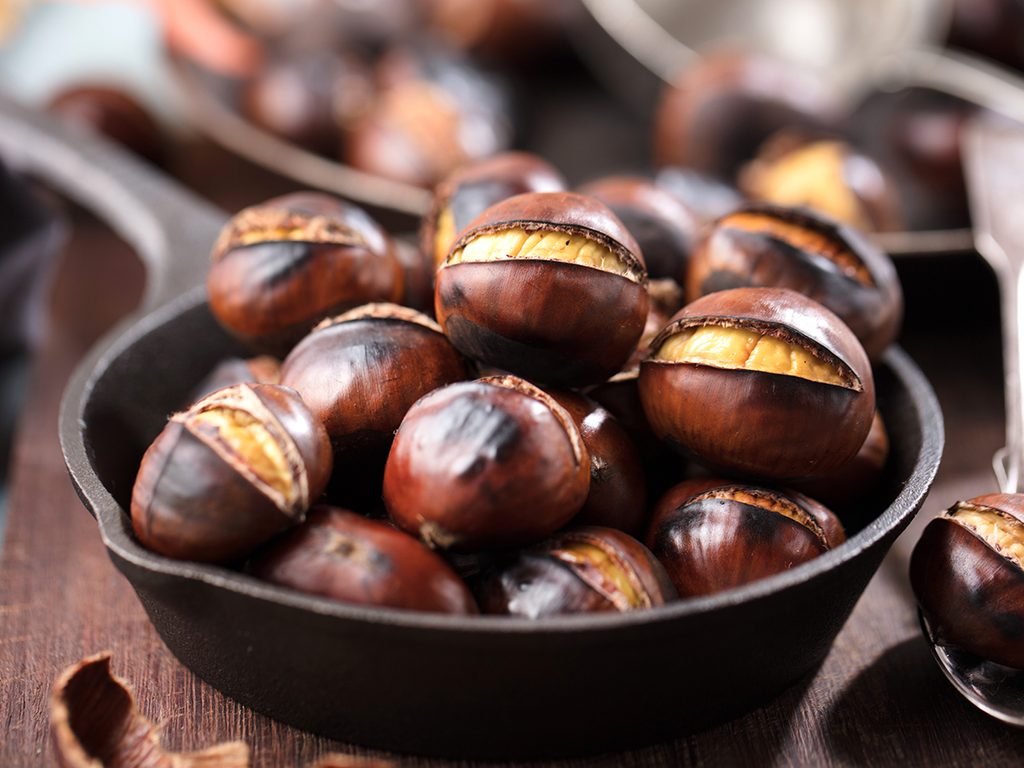The Surprising Health Benefits of Chestnuts

Plus, tips on how to prepare this seasonal nutritional powerhouse
Roasted chestnuts are one of my favourite treats during the winter holiday season. Growing up, I loved the ritual of shelling and sharing them with my family, and of course their rich, buttery taste. Now, I also appreciate their nutritional punch.
Chestnuts come from the sweet chestnut tree and were first cultivated in the Mediterranean 3,000 years ago. They grow in a prickly green casing called a burr, which splits open and falls from the tree once its ripe. The season for chestnuts is relatively short, from October through December. Scoop them up while you can!
(Related: The Real Health Benefits of Eating Poppy Seeds)
Health benefits of chestnuts
Chestnuts have a creamy texture, but are approximately 40 percent water, so they’re lower in fat and calories than other nuts, such as almonds or walnuts. They’re chock-full of complex carbohydrates and fibre, which keep you feeling full and provide a stable supply of energy throughout the day, helping to prevent blood sugar spikes and crashes
One serving (about ¼ cup) contains about 20 percent of your daily recommended intake of vitamin C and 25 percent of your recommended copper intake. Vitamin C and copper are antioxidants and support the body’s production of collagen, an essential for healthy joints and skin. Both keep your immune system strong and help fight off infections.
How to prepare and use chestnuts
You can include chestnuts in savoury and sweet recipes, and the best preparation method depends on the type of dish you’re making. For salads, snacks, and stuffing, keep the chestnuts dry by roasting them. For soups and purées, boiling is best, so the chestnuts are softer and easier to blend. Use a knife to score an ‘x’ on both ends of the chestnuts before boiling or roasting (this will prevent them from exploding during cooking). When the ‘x’ pops open, the chestnuts are done, and the hard, outer shell and membrane can easily be removed.
Chestnuts provide rich flavour and texture to bread stuffing for meat and poultry roasts; or, pop them in the oven alongside vegetables like Brussels sprouts to breathe new life into standard side dishes. They are starchier than other nuts, so they have thickening power, which helps to add creaminess to soups and purées.
On the sweeter side, look for crème de marrons, a classic French spread made from ground chestnuts and sweetened with sugar. Try it on toast or crepes or add it to steamed milk to create a festive spin on a latté.
(Related: You’re Going to Want to Get Pomegranates Right Now)
What to look for when buying chestnuts
Look for glossy shells and give them a shake — if they rattle, they’ve dried out. Chestnuts perish quickly but will last up to one week in the fridge.
Fresh chestnuts have the best texture and flavour but shelling them can take a while. If you’re pressed for time, the pre-roasted, shelled, and vacuum-packed varieties work well. These are also great for snacking. Canned chestnuts work, too, but drain and dry them thoroughly before using in cooking.
Don’t miss your chance to do more than sing about this wintertime gem — no open fire required!
Laura Jeha is a Registered Dietitian, nutrition counsellor, recipe developer and food writer living in Toronto. Find out more at ahealthyappetite.ca.




